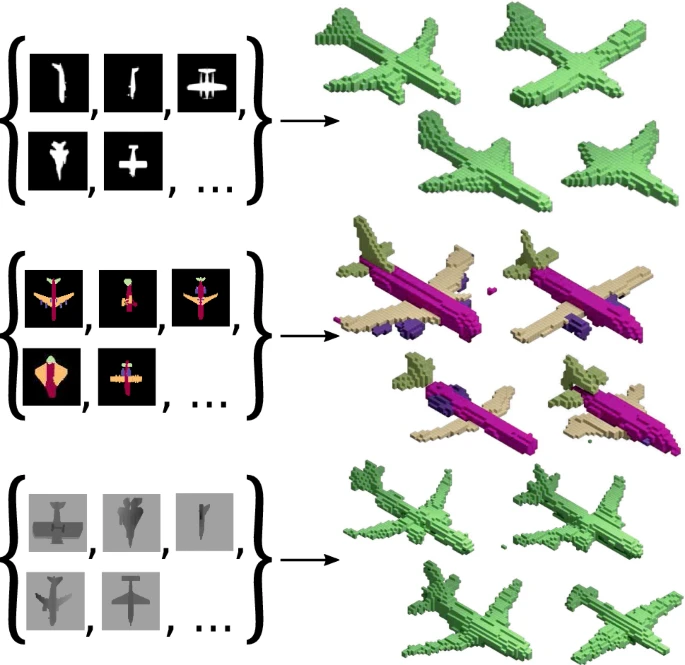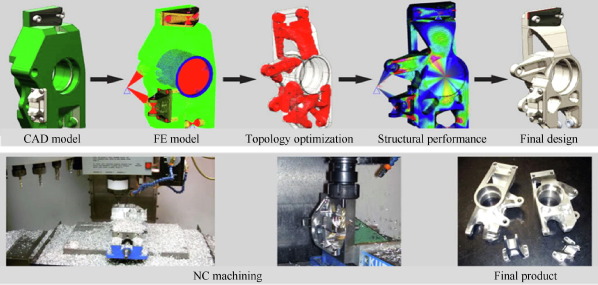Design Innovation - AI-Generated CAD vs NLP Interactive CAD
1. Understanding AI-Generated CAD Design
AI-generated CAD is a cutting-edge approach to design automation. It utilizes machine learning and deep learning to identify patterns from existing design data. Based on this knowledge, it can autonomously generate new designs with minimal human intervention. Techniques such as Generative Adversarial Networks (GANs) and Variational Autoencoders (VAEs) are commonly used in these systems.
Key Technical Elements:
- Generative Models: GANs and VAEs play a central role in generating new design ideas by learning from large datasets of existing designs. These models help produce innovative structures and shapes that are often beyond the scope of conventional design methods.

GAN algorithm for 3D shape generation, image source: Matheus. G., et al (2020)
- Topology Optimization: AI-powered CAD systems can apply topology optimization, which involves maximizing performance while minimizing material usage based on desired objective functions. This is particularly valuable in industries such as aerospace and automotive, where lightweight, high-performance structures are critical.

Toporogy optimization process and CAM based CNC machining. image source: Jihong, Z., et al. (2021)
Advantages:
- Time and Effort Savings: AI-driven automation significantly reduces the time and labour involved in generating designs, especially when dealing with complex systems or large datasets.
- Multidimensional Optimization: AI can simultaneously optimize multiple design parameters, including strength, weight, and material usage, to achieve the most efficient outcomes.
Challenges:
- Data Dependence: AI’s ability to generate creative designs is constrained by the quality and diversity of the data it is trained on. Without sufficient variety in the training data, AI may fail to propose truly novel ideas.
- Lack of Interpretability: A major challenge with AI-generated CAD is its “black-box” nature. The designs produced by AI may be difficult to interpret or explain, which can pose a barrier in fields that require clear decision-making and traceability.
- Feature Dependencies and Sequential Design: Traditional CAD relies on sequential 2D sketches and extrusions to form 3D shapes. During this process, the creation of features like bodies, faces, lines, and points often depends on a specific order. This structured order plays an essential role in managing and modifying designs. In contrast, AI-generated designs are typically represented as collections of discrete data points, such as voxels or point clouds, which may not follow these established dependencies. As a result, many AI-generated models lack the intuitive structure required for effective refinement in traditional CAD workflows. However, methods that incorporate sketch-based learning have been proposed to address this issue, though they are still in the development phase.

Extrusion process of CAD operation process, image source: Design Workshop Sydney
2. The Role of NLP in Interactive CAD Design
Natural Language Processing (NLP) enables more intuitive interactions within CAD systems. By allowing users to issue commands in natural language, these systems can interpret the instructions and generate or modify 3D models accordingly. My blog post about NLP-based CAD is available for further basic information (Blog post: The Future of 3D CAD Design with Natural Language Processing)
Key Technical Elements:
- Natural Language Understanding: Large language models (LLMs) such as GPT-4, DeepSeek, and BERT understand user commands. For instance, a user might instruct the system with a sentence like “Create a central tower of 80 m in height, surrounded by four smaller towers, each with a radius of 12 m, placed in four directions.” These systems can parse the language and convert it into executable CAD instructions.

LLM baesd interaction with CAD system, image source: Akshay B., et al (2024)
- Code Generation: Once the natural language input is understood, the system generates the corresponding CAD code to realize the user’s design. This seamless interaction makes CAD systems more accessible to people without technical expertise.
Advantages:
- User-Friendliness: NLP-based CAD systems make it easier for non-experts to engage in design by allowing them to express their ideas through natural language, removing the need for detailed technical knowledge.
- Faster Prototyping: NLP enhances the ability to quickly generate or modify models, speeding up the design process and making rapid iteration more feasible.
- Integration with VR/AR: NLP-based CAD systems hold great potential for integration with Virtual Reality (VR) and Augmented Reality (AR). This would enable immersive design experiences where users can interact with and modify models in a 3D virtual space (Cyberspace), offering more intuitive and engaging design workflows. Also, the generated models would easily be utilized for digital twin simulation in manufacturing processes or product characteristics.
Challenges:
- Ambiguity in Language: Natural language can be inherently ambiguous, leading to potential misinterpretations of design instructions. For instance, a phrase like “Make the design thinner” could be understood in various ways depending on context.
- Complexity of Expression: While simple designs can be easily described, more intricate design commands may be difficult to articulate effectively in natural language, which may require advancements in NLP technology.
3. Comparing AI-Generated CAD and NLP Interactive CAD
| Aspect | AI-Generated CAD | NLP Interactive CAD |
|---|---|---|
| Automation Level | High (AI autonomously generates designs) | Moderate (based on user input) |
| User Involvement | Low (minimal human interaction) | High (active user participation) |
| Creativity | Data-dependent (innovation is constrained) | Reflects user creativity |
| Application Scope | Well-suited for data-intensive fields | Applicable across diverse domains |
| Technical Challenges | Black-box nature, low interpretability | Ambiguity in natural language |
| Feature Dependency | Lacks feature dependency awareness, leading to disjointed designs | Maintains user-defined feature structure |
| Integration Potential | Limited integration with existing CAD workflows | Easy integration with traditional CAD systems and VR/AR applications |
4. Conclusion: The Need for Integration of Both AI and NLP
AI and NLP each bring unique strengths to the world of CAD design. AI excels at generating innovative designs based on existing data, offering efficient, optimized results that would be challenging for humans to conceive. However, the design process is inherently tied to human creativity and problem-solving. While AI can assist, it cannot replace the human touch in refining designs to meet practical and aesthetic goals.
NLP-based systems, on the other hand, provide a more interactive and intuitive design experience. They make design accessible to users with little technical expertise and can speed up the prototyping process. Moreover, NLP can preserve the feature dependencies and the logical flow that is crucial in traditional CAD workflows, making it easier for human users to guide and refine designs.
Both approaches have their merits, and neither is inherently superior to the other. The future of CAD design lies in the integration of AI’s generative power with NLP’s interactive capabilities. By combining these methods, we can create more efficient, intuitive, and accessible design tools that empower both expert designers and non-technical users alike.
- Please share your thoughts via comment or email!
- Follow my social media (LinkedIn, X), which will provide you with the latest blog posts!
Enjoy Reading This Article?
Here are some more articles you might like to read next: